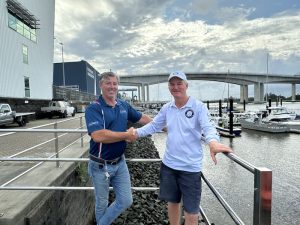Preparing for climate reporting: Find the gaps and be ahead of time

- by Admin
- August 26, 2024

Australia’s business landscape is preparing for numerous new climate reporting regulations. Experts from FTI Consulting outline how leaders can prepare for such changes, and why they should strive for implementation beyond compliance, using the new regulatory requirements as an opportunity to drive business value.
Many companies wait until mandatory climate reporting is imminent to pull together a tick-box governance and reporting process: hastily determining risks, adding a few points to their risk register and devising adaptation strategies that are not given enough scrutiny and due diligence to deliver business value.
At FTI Consulting, we advise our clients to start preparing for climate reporting as soon as possible, even if a company is not required to report for a couple of years. Climate risk management requires every level of an organisation to be prepared, involving education, training and whole-of-business engagement on how climate risks and opportunities can be tackled.
Wherever you are in your climate reporting journey, starting small but soon is key. For most, this will involve finding gaps in an existing reporting suite, understanding industry best practices and reorganising an organisational chart to deliver on climate.
Not all reporting requirements are new
Having to factor climate-related risks into business planning may stir up concern for some, however existing business structures and initiatives can be leveraged for reporting in their climate response. It is not a coincidence that frameworks for the management of climate risks and opportunities draw on familiar business concepts and language. This allows companies to understand them easily and recognise where an uplift in organisational structure, strategy and risk management can be implemented to factor in climate.
If a company already manages any non-financial sustainability-related risks, these structures could be replicated or adapted for climate. If not, existing structures for other business risk management can be used.
Finding the gaps
Companies with some form of climate reporting can begin by understanding gaps in their reporting suite and aligning with existing industry best practices. The following is a brief guide to expose the gaps:
Regulatory requirements
A good place to start is a regulatory and market reporting requirement assessment. Depending on your presence, international or local, you might have to consider jurisdiction-specific requirements. For example, are you required to report under the Corporate Sustainability Reporting Directive (CSRD) in Europe or only under the Australian Sustainability Reporting Standards (ASRS) in Australia?
Gap analysis
Once you know the framework(s) you are aligning to, a simple gap analysis can determine where you can use what you have and where you might need additional responses or workstreams for climate reporting. Which disclosures are missing and what is required to fulfil them?
Industry benchmarking
There is great value in knowing what your peers and industry are doing. Many companies have been reporting on climate for several years. While compliance-oriented climate reporting is new, with some reporting nuances and precedents yet to be established, examples of robust climate disclosure exist for you to leverage when preparing your reporting to ensure it is fit for purpose.
Organisational readiness
Beyond outlining climate risk and strategy, you will need to demonstrate appropriate governance structures to deliver on your plans. Do you have relevant oversight of climate risk at board level? Does your executive team have the right knowledge and skills to deliver? Are your employees ready to support your plans? These are the questions you will likely need answers to.
Further reading: Preparing for ISSB standards and climate-related financial disclosures.
Building knowledge within the organisation
Many organisations in Australia are new to climate risk and opportunity management and will require education across all levels of the business, from the board down, on their climate deliverables. Building knowledge through board information sessions, management workshops and understanding employee awareness of climate change risk and adaptation (and what it involves) is a good place to start before moving on to risk assessment and governance structure changes.
However, it is vital to take this beyond the board and management team.
While the initial stages of a climate risk assessment and strategy are largely reserved for the leadership, implementation is not. Depending on the risks and opportunities identified and the degree of exposure to climate risk, almost every level of the organisation needs to be aware of what a company’s climate resilience planning involves and what everyone’s contribution to it looks like. Early involvement makes engagement easier down the line.
Communicate early
Companies do not have to wait to start communicating about and engaging their stakeholder group on climate. Climate disclosures can be published in the company’s reporting suite before mandatory requirements come in to demonstrate progress, gauge stakeholder reactions and benchmark against peers.
Addressing a company’s climate-related plans openly in its communications and marketing materials is also important. Several stakeholders, from employees to customers, suppliers and the community, are seeking this information. Being transparent and providing useful information in communications only builds trust and a company’s reputation.
Finally, the energy transition is not going to be delivered by companies working on their climate plans in silos. Collaborating on sustainability initiatives can foster industry engagement, garner state and federal support and increase community engagement, which are all key to shore up support for climate planning, innovation and solutions. Early stakeholder engagement can support future technology research, setting industry-wide emissions reduction targets or jointly working with communities to understand climate action, approaches and benefits.
The Latest News
-
December 25, 2024Where to watch Australia vs. India 4th Test: Free live stream, free-to-air channel, start time for cricket match | Sporting News Australia
-
December 25, 2024Gearing Up for Australian Open, Nick Kyrgios Elevated in Bold Predictions From Renowned Tennis Experts
-
December 25, 2024Dads’ day out! Australian stars unwind with with wives, kids at MCG. Watch | Cricket News – Times of India
-
December 25, 2024Border-Gavaskar Trophy: What is Australia’s record in Melbourne in Test matches? | Sporting News Australia
-
December 25, 2024India must continue to exploit ‘brittle’ Australian line-up: Ravi Shastri | Cricket News – Times of India



